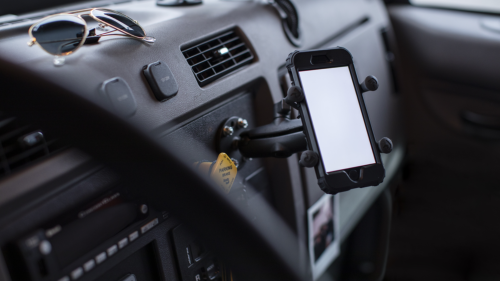We’re always working to make our roads safer. That’s why we’re adding two new safety metrics for Relay carriers this fall: driver violation rate and vehicle violation rate.
Relay will still require compliance with CSA BASIC scores, which measure safety across categories, such as maintenance and HOS compliance. But we’ll now add violation rate metrics, which offer a data-driven view of how well carriers proactively manage inspections and respond to violations over time. Carriers with rates below our thresholds have shown a strong safety record.
Along with Relay’s other safety requirements, here’s how these metrics will help carriers operate responsibly and maintain a strong safety culture.
Driver violation rate
- A calculation based on how often driver-related violations occur during roadside inspections (greater emphasis on out of service violations).
- Helps identify areas where the carrier may want to add additional driver training.
- Must be at or below 35% to haul with Relay.
Vehicle violation rate
- A calculation based on how often vehicle-related violations occur during roadside inspections (greater emphasis on out of service violations).
- Helps the carrier spot maintenance needs before they become problems.
- Must be at or below 50% to haul with Relay.
How are Relay’s violation rate metrics calculated?
These metrics will use FMCSA inspection data over the past 12 months to track how often a carrier’s fleet or drivers receive violations during inspections.
To calculate a clear view of a company’s safety performance, Amazon Relay uses:
- Non-OOS (Out-of-Service) violations: Any driver violation that doesn’t result in being taken out of service.
- OOS violations: Serious violations that require the driver or vehicle to be removed from service.
- Total driver/vehicle inspections: All inspections over the rolling 12 months.
We add non-OOS violations to OOS violations (which are weighted twice as much to reflect their higher risk), then divide by total inspections. The formula applies when calculating either driver or vehicle inspection rates.
We consider:
These rates reflect the likelihood that an inspection will result in a violation, helping carriers identify categories where their company’s drivers and equipment face risks to prioritize coaching and maintenance.
When will Relay enforce these safety metrics?
- New carriers onboarding to Relay will be screened for our violation rates starting October 31, 2025. They need to maintain 35% or below for driver violations and 50% or below for vehicle violations.
- We’ll start enforcing these limits for existing carriers in February 2026. Rates are calculated based on a carrier’s total number of roadside inspections.
Carriers with three or more inspections that exceed our violation limits may lose access to Relay loads. Like BASICs violations, we won’t offer an appeal process. Carriers are responsible for flagging their most common violations and introducing targeted solutions. The Relay Safety Scorecard makes it easier to spot patterns that can be improved.
What is Relay’s Safety Scorecard?
Approved Relay carriers have a Safety Scorecard in their account on the Relay portal or app. This is where they can see where their violation rates stand and get tips to build stronger safety practices – before roadside inspections affect their ability to haul with Amazon.
Why road safety standards matter
Relay’s driver and vehicle violation rates will encourage carriers to track past inspections, violations, and take corrective actions. As carriers identify safety trends and prevent repeat violations, it’ll mean:
- Public safety: There’s a potential for fewer accidents and injuries, since higher violation rates are strongly correlated with crashes and unsafe conditions.
- Efficient operations: Carriers with high violation rates may face increased DOT inspections, fines, or even temporary shutdowns. Violation rates will encourage carrier interventions, audits, and coaching, which will lead to less downtime and more cost savings for carriers, and more reliable delivery for customers.
- Load access: Clean, low-violation fleets improve carrier access to Amazon loads.
Tips to keep DOT violation rates low
Violation rate metrics will mark an important change in how we keep our roads safe. Before we start enforcing the rate limits, carriers can:
- Proactively inspect and maintain vehicles: Conduct pre-trip inspections, schedule regular maintenance, and keep clean maintenance records.
- Coach safe driver behavior: Monitor speed, HOS compliance, and controlled substance policies. Use training programs to reinforce safe practices. Keep driver documentation (e.g. license, medical card, etc) current and available for inspection.
- Celebrate clean inspections: Reinforce the impact of overall safety culture as a team. Every clean inspection can be a learning opportunity.
FMCSA also offers free resources to improve safety programs.
- What can a motor carrier do to improve?
- Driver Safety Education Center
- Motor Carrier Resource Center
- Help Motor Carriers Get Road Smart
Ready to start hauling?
Safety matters – and safe roads create opportunities for everyone. We’re looking for carriers who share our commitment to safety. If you’re interested in joining Relay, check if your business meets our carrier requirements. Then start your Relay application on your desktop or in our app on iOS or Android.
Disclaimer: Amazon does not tender loads through any third-party load boards. Any Amazon loads posted on third-party load boards will only be tendered directly to approved and onboarded carriers via the Relay web portal or Relay mobile app. If you are interested in hauling loads for Amazon, sign up and book directly on relay.amazon.com. For more about our efforts against fraud and cargo theft, see our trustworthy transportation page.








